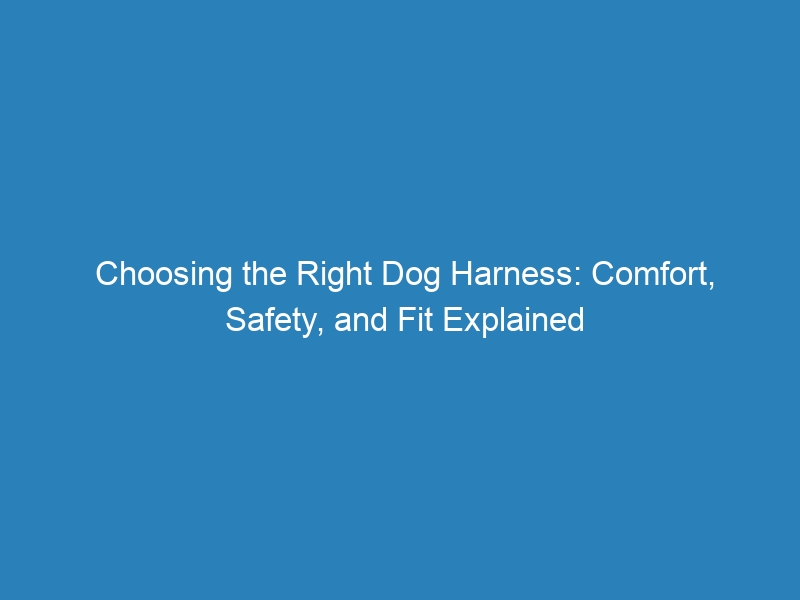Choosing the Right Dog Harness: Comfort, Safety, and Fit Explained

In terms of your canine companion, selecting the appropriate dog harness is vital for their comfort, safety, and overall enjoyment during walks.
A well-fitted harness can significantly enhance your dog’s sense of security while minimizing the risk of injury. This article outlines the essential features to consider in a harness, ranging from comfort-enhancing designs to important safety measures. It also provides a step-by-step guide on how to accurately measure and fit the harness.
Furthermore, the article compares different types of harnesses and delves into the best materials suited for various activities and climates, enabling you to make an informed decision for your pet.
Understanding the Importance of Choosing the Right Dog Harness
Choosing the right dog harness is essential for ensuring your pet’s comfort, safety, and proper fit. A well-fitted harness plays a significant role in your dog’s safety during walks and outdoor activities, offering effective leash control and support.
It is important to select a harness that accommodates your dog’s behavior and specific needs—whether you have an active dog, a puppy, or an elderly dog—as this can enhance the overall dog-walking experience while upholding quality pet ownership.
Understanding the various harness types and features will enable you to make an informed decision that prioritizes your dog’s comfort and safety.
Why a Properly Fitted Harness is Essential
A properly fitted dog harness is essential for maximizing your dog’s comfort and ensuring safety during walks and outdoor activities.
When a harness fits well, it distributes pressure evenly across your dog’s body, which reduces the risk of injury and enhances mobility. Conversely, an ill-fitted harness may cause discomfort, potentially leading to anxiety and behavioral issues during walks.
This discomfort can result in your dog pulling more or even attempting to escape, posing dangers for both the pet and the owner.
Safety features such as adjustable harnesses and escape-proof designs are important to ensure that your dog remains secure. It’s crucial to recognize that ensuring the right sizing is not just about fit; it significantly impacts your dog’s overall confidence and enjoyment during outdoor adventures, promoting a positive experience for both you and your pet.
Comfort Considerations for Your Dog
When selecting a dog harness, it is crucial to prioritize comfort to ensure a positive experience for both you and your dog.
A padded harness designed with ergonomic principles can greatly enhance your dog’s comfort, especially during long walks or outdoor activities.
Choosing materials that provide breathability and a comfortable fit is essential for preventing overheating and irritation.
Moreover, taking the time to understand your dog’s unique needs and preferences will assist you in selecting the most suitable options for their comfort.
Features that Enhance Comfort
Certain harness features can significantly enhance your dog’s comfort during walks and outdoor adventures. It is advisable to look for padded harness designs that offer extra cushioning while also considering adjustable options for a personalized fit.
These features are essential, as they not only promote your dog’s physical well-being but also contribute to a more enjoyable experience for both you and your pet. A well-padded harness helps distribute pressure evenly, preventing chafing or irritation, which is particularly important during longer outings.
Adjustable harnesses can accommodate growing puppies or dogs with unique body shapes, ensuring a snug yet comfortable fit. Additionally, incorporating reflective strips can provide an extra layer of safety during nighttime walks, allowing you to have peace of mind while keeping your furry companion secure and comfortable.
Safety Features to Look for in a Dog Harness
Safety features are paramount when selecting a dog harness, as they directly influence your dog’s well-being during outings.
It is essential to look for harnesses that incorporate reflective materials to enhance visibility during nighttime walks, ensuring your dog’s safety in low-light conditions.
Additionally, consider escape-proof designs, which offer peace of mind by preventing your dog from slipping out of the harness during walks or outdoor activities.
Protecting Your Dog from Injury
To protect your dog from injury, it is vital to choose a harness with specific safety features. Proper use of a harness—ensuring correct fitting and adjustments—can prevent discomfort and injuries during walks.
Look for features that enhance safety, such as padded designs and secure leash attachment points, to ensure that your dog remains safe and comfortable during training or outdoor activities.
It is crucial to regularly check the harness for any signs of wear and tear, as a damaged harness can compromise safety. Ensuring the harness is snug but not too tight will allow for natural movement without causing chafing or restriction.
You should also consider your dog’s specific breed and size, as certain designs and features are tailored to enhance their unique physical needs.
By prioritizing the correct selection and usage of a harness, you can significantly reduce the risk of injuries related to pulling or sudden movements. This, in turn, creates a more enjoyable experience for both you and your dog.
How to Measure and Fit a Dog Harness
Measuring and fitting a dog harness correctly is essential for ensuring your dog’s comfort and safety. An ill-fitted harness can lead to discomfort and potential injury.
Start by measuring your dog’s girth, taking into account breed specifications and specific needs based on their size and activity level.
By following a detailed fitting guide, you can ensure that the harness is snug yet comfortable, allowing for proper use during walks and outdoor excursions.
Step-by-Step Guide for Proper Fitting
A step-by-step guide to fitting your dog’s harness effectively can significantly enhance their comfort and safety. Begin by selecting the appropriate size based on your dog’s measurements, then adjust the chest strap and other components to ensure a snug fit without restricting movement.
It is essential to regularly check and make necessary adjustments to accommodate any changes in your dog’s size or comfort level, thus ensuring that the harness remains a reliable tool for daily walks.
Thoroughly measure the circumference of your dog’s chest and neck, and compare these measurements to the sizing chart provided by the harness manufacturer. Once the harness is on your dog, take a moment to verify that you can slide two fingers between the harness and your dog’s skin, indicating a fit that is secure yet comfortable.
As your furry friend grows or experiences weight fluctuations, remember to revisit the sizing to ensure the harness isn’t too tight or loose. Consistent adjustments not only keep your dog safe but also ensure they remain happy during every adventure you share together.
Different Types of Dog Harnesses
Understanding the various types of dog harnesses available is essential for selecting the best option for your pet’s needs and behavior.
Harness types differ in design and purpose, including:
- Back clip harnesses suitable for everyday use
- Front clip harnesses designed for better leash control
- No-pull harnesses that help discourage pulling during walks
Each type is specifically tailored to accommodate different dog breeds and behaviors, ensuring both comfort and safety during walks and outdoor activities.
Comparing Styles and Uses
Comparing styles of dog harnesses is essential for determining which one best suits your dog’s needs and behavior. Understanding the nuances of different harness designs can significantly enhance both the walking experience and training outcomes for your furry friend.
Back clip harnesses are particularly favored for their simplicity; they are easy to slip on and off, making them ideal for casual outings around the neighborhood. Conversely, front clip harnesses are designed for better control, effectively discouraging pulling by redirecting your dog’s attention toward you. This can be especially beneficial during training sessions or for dogs with a tendency to lunge.
There are also no-pull harnesses that combine elements from both styles, allowing for superior comfort while promoting positive walking behavior. By weighing the benefits of each harness type, you can forge a stronger connection with your dog during daily walks.
Choosing the Right Material for Your Dog’s Harness
Selecting the appropriate material for your dog’s harness is essential to ensure durability, comfort, and functionality across different activities.
It is important to consider materials that provide breathability and resilience to endure outdoor conditions while remaining easy to clean.
The right material not only improves the performance of the harness but also plays a significant role in your dog’s overall well-being, particularly during active outings.
Factors to Consider for Different Activities and Climates
When selecting a harness, it is essential to consider the specific activities and climates in which your dog will be engaged. For example, a reflective harness is ideal for nighttime walks, ensuring visibility and safety.
Similarly, choosing a harness made of lightweight and breathable materials is crucial for warm climates, while sturdier options may be more appropriate for rugged outdoor activities.
Harnesses designed for specific purposes—such as training, hiking, or running—can significantly enhance both comfort and effectiveness during these activities. In colder climates, insulated harnesses provide extra protection against harsh weather conditions, whereas a waterproof harness is essential for rainy days to keep your dog dry and comfortable.
It is also important to adjust the fit of the harness based on your dog’s activity level, ensuring they can move freely without restrictions, which is particularly vital for active breeds. By taking these factors into account, you can ensure that the chosen harness meets both the functional needs of your dog and the safety requirements of the environment.
Frequently Asked Questions
1.
What should I consider when choosing the right dog harness for my furry friend?
There are a few key factors to keep in mind when selecting a dog harness. Comfort, safety, and fit are the three main components to consider. You want to make sure the harness is comfortable for your dog to wear, provides adequate safety, and fits snugly without causing any discomfort or restriction of movement.
2.
How can I ensure my dog’s harness is comfortable for them?
To ensure your dog’s harness is comfortable, look for materials that are soft and breathable, such as mesh or padded fabrics. You should also make sure the harness is properly sized for your dog’s body and doesn’t rub or chafe their skin. It’s also a good idea to choose a harness that distributes pressure evenly instead of putting all the weight on one specific area.
3.
What safety features should I look for in a dog harness?
When choosing a dog harness, it’s important to look for features that prioritize safety. This can include reflective strips for increased visibility during walks, sturdy clips and buckles, and a handle on the back for easy lifting and control. It’s also important to make sure the harness doesn’t restrict your dog’s breathing or cause discomfort in any way.
4.
How do I know if a dog harness fits properly?
A properly fitting dog harness should be snug but not too tight. You should be able to fit two fingers between the harness and your dog’s body. The harness should also be adjustable to ensure a custom fit for your dog. Make sure to measure your dog’s chest and neck before purchasing a harness to ensure the best fit.
5.
Can I use a dog harness for all types of activities?
It’s important to choose a harness that is suitable for the specific activity you will be doing with your dog. For example, a harness with a front clip is better for leash training, while a back clip harness is better for casual walks. If you plan on taking your dog on adventures, look for a harness that is designed for outdoor activities and provides extra support and protection.
6.
Are there any other features I should look for in a dog harness?
Along with comfort, safety, and fit, there are a few other features to consider when choosing a dog harness. These can include adjustable straps for a more customized fit, a handle on the back for easy lifting, and the ability to attach accessories such as lights or waste bag holders. It’s also a good idea to choose a harness with a warranty in case of any defects or issues with the product.
Choosing the Right Dog Harness: Comfort, Safety, and Fit Explained When it comes to walking equipment, dog harnesses offer superior control and comfort compared to traditional collars. Understanding how to choose and fit the right harness can make a significant difference in your daily walks.


Recent Comments